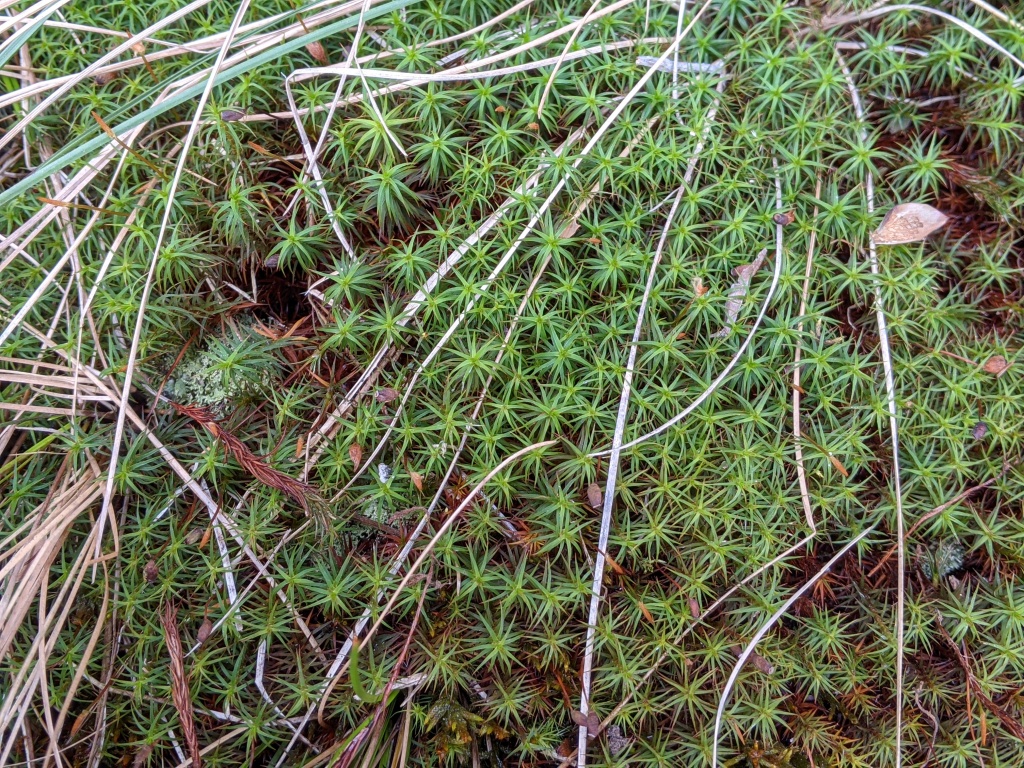Polytrichastrum
Dioicous. Loose tufts. Aerial stems simple or branched, with rhizoids restricted to stem base and bases of lowermost scale-like leaves. Leaves linear-lanceolate from a sheathing base, scale-like at stem base, becoming larger toward stem apex, erect-spreading to squarrose when moist, appressed or erect-spreading when dry, with most of adaxial surface covered with lamellae, except for up to 10 rows of cells along margins; lamellae to 11 cells tall; apex acute or acuminate; costa percurrent (not in Victoria) or slightly excurrent; margin serrate, denticulate (not in Victoria) or entire (not in Victoria), upcurved, unistratose; laminal cells ovate to subquadrate or hexagonal, becoming rectangular in sheath, smooth. Capsule erect to horizontal, ovoid, globose, ellipsoid or short-cylindric, terete or 4–6-angled, with numerous stomata. Calyptra cucullate, densely hairy. Operculum rostrate. Peristome of 64 or rarely 32 (not in Victoria) teeth, attached at maturity by their apices to the epiphragm usually via elongated erect epiphragm teeth.
Ten species spread throughout temperate to polar regions; one species in Victoria.
Smith (1971) created Polytrichastrum through the transfer of several Polytrichum species and established section Aporotheca within Polytrichastrum, which included Victorian Polytrichum formosum Hedw. This section differed from Polytrichum by sporophytic characters such as the absence of downward pointing rounded teeth along the margins of the epiphragm (sacculi) and the lack or ridges on the inner surface of the peristome teeth (Bell & Hyvönen 2010a). However, phylogenetic analyses of combined DNA sequences from all genomic compartments revealed that the closest relative of section Aporotheca is Polytrichum, rather than other Polytrichastrum species as would be expected if the section Aporotheca was most appropriately placed in Polytrichastrum (Bell & Hyvönen 2010b; Bell et al. 2021). Consequently, Bell & Hyvönen (2010a) advocate for section Aporotheca to be recognised in Polytrichum as is done here. In this revised circumscription of Polytrichastrum, Polytrichastrum can be distinguished from other Polytrichaceae by having elongated erect teeth along the margin of the epiphragm (epiphragm teeth) or in the one exception where these are absent, terete capsules with 64 peristome teeth (Bell & Hyvönen 2010a; Bell et al. 2021). Polytrichastrum can also be distinguished from Polytrichum by the terete or multiple-angled capsules that are often more than 4-sided (Bell & Hyvönen 2010a; Bell et al. 2021).
Polytrichastrum is an early coloniser of open or peaty soil (Hyvönen 2006).
 Spinning
SpinningBell, N.E.; Hyvönen, J. (2010a). A phylogenetic circumscription of Polytrichastrum (Polytrichaceae): Reassessment of sporophyte morphology supports molecular phylogeny. American Journal of Botany 97: 566–578.
Bell, N.E.; Hyvönen, J. (2010b). Phylogeny of the moss class Polytrichopsida (BRYOPHYTA): Generic-level structure and incongruent gene trees. Molecular Phylogenetics and Evolution 55: 381–398.
Bell, N.; Kariyawasam, I.; Flores, J.; Hyvönen, J. (2021). The diversity of the Polytrichopsida–a review. Bryophyte Diversity & Evolution 43: 98–111.
Hyvönen, J. (2006). Polytrichastrum, in McCarthy, P.M. (ed.), Flora of Australia, Mosses 1, Vol. 48, pp. 137–140. ABRS and CSIRO, Canberra and Melbourne.
Smith, G.L. (1971). A conspectus of the genera of Polytrichaceae. Memoirs of the New York Botanical Garden 21: 1–83.

